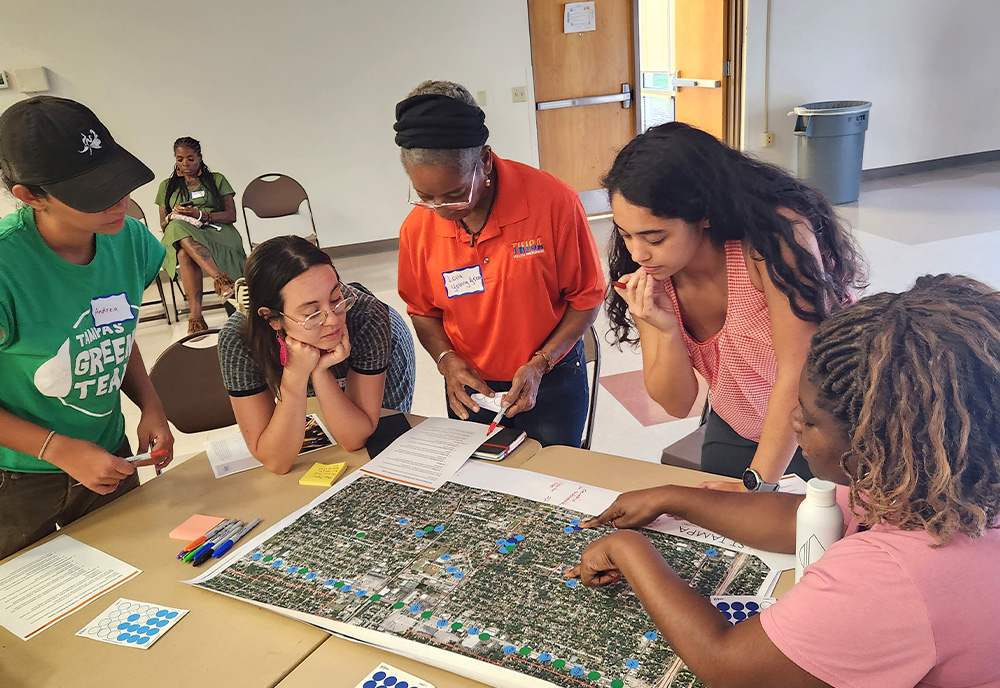By Cassidy Delamarter, USF Communications and Marketing
With Tampa on track for record-breaking heat this summer, University of South Florida researchers are collaborating with the city of Tampa to implement strategies that can help protect the city and its residents. The project, Bridging Knowledge to Action, will direct the city’s efforts to enhance resilience through new initiatives, including planting more trees and establishing dedicated spaces for individuals to cool down.
The research, led by Taryn Sabia, assistant dean for research in the USF College of The Arts, began in 2022 with funding from the National Academies of Sciences, Engineering and Medicine’s Gulf Research Program. By combining social demographics with land surface temperature maps, Sabia and her team developed the Heat Vulnerability Index, which identified a strong correlation between lower-income neighborhoods and higher temperatures.
“These communities often lack the resources to make necessary improvements to cope with rising temperatures, making them particularly susceptible to heat-related health issues,” said Sabia, who’s also an associate professor of research in the School of Architecture & Community Design.
The findings revealed that East Tampa is a critical area, disproportionately impacted by extreme heat. The neighborhoods, primarily minority and lower-income households, are characterized by older, poorly insulated homes with concentrations of at-risk groups, such as senior citizens, children, outdoor workers and those with underlying medical conditions, such as asthma.

“The University of South Florida is one of our most extraordinary partners and over the years their researchers have helped us analyze and address some of our most challenging issues,” Tampa Mayor Jane Castor said. “Now, they are helping us find real solutions to endure dangerously high temperatures that affect absolutely everyone in our city. We are grateful for their involvement in the development of Tampa’s first Heat Resilience Playbook, as this is a critical step to ensure what we do moving forward protects our quality of life, and above all, the health and well-being of our residents for years to come.”
Since 2016, Tampa’s heat index has consistently exceeded 100 degrees for more than 45 days per year. In 2023, Tampa experienced the hottest July on record with an average high temperature of 93.3 degrees Fahrenheit and an average low of 79.7 degrees Fahrenheit, minimizing the city’s ability to cool off overnight.
The research helped lead to the development of the city’s first-ever Heat Resilience Playbook, a dynamic document with 18 actionable steps to increase access to spaces of refuge and enhance and protect the tree canopy.
“The playbook will guide city officials as they create equitable and effective climate resilience strategies citywide,” said Shawn Landry, research associate professor and director of the USF Water Institute.
Every five years, Landry analyzes the health of the Tampa tree canopy and urban forest. In his most recent report in 2021, Landry found the tree canopy to be highly productive in some areas, mitigating direct sun exposure and reducing cooling costs. But the canopy has been declining in recent years due to new construction, storm damage and other possible reasons.
The report is included in the playbook and will be used to guide officials as they plant new trees, ensuring they are strategically located so they don’t negatively impact existing sidewalks and structures in the future as their roots grow.
Another innovative strategy emerging from the project is the creation of “cool corridors.” These shaded, comfortable pathways will connect residents to essential community amenities, such as libraries and community centers. This initiative addresses the needs of transportation-disadvantaged communities by providing walkable routes that reduce exposure to extreme heat.
The USF team plans to continue partnering with the city to ensure the playbook reflects continuous real-time data collection, community feedback and the evolving needs of citizens. Sabia will also expand efforts in East Tampa to explore ways to rehabilitate the older structures and homes.
This piece was originally published at https://www.usf.edu/news/2024/usf-architecture-and-water-researchers-partner-with-city-of-tampa-to-mitigate-the-impact-of-extreme-heat/usf-architecture-and-water-researchers-partner-with-city-of-tampa-to-mitigate-the-impact-of-extreme-heat.aspx.
Sign up for The Invading Sea newsletter by visiting here. If you are interested in submitting an opinion piece to The Invading Sea, email Editor Nathan Crabbe at nc*****@*au.edu.



